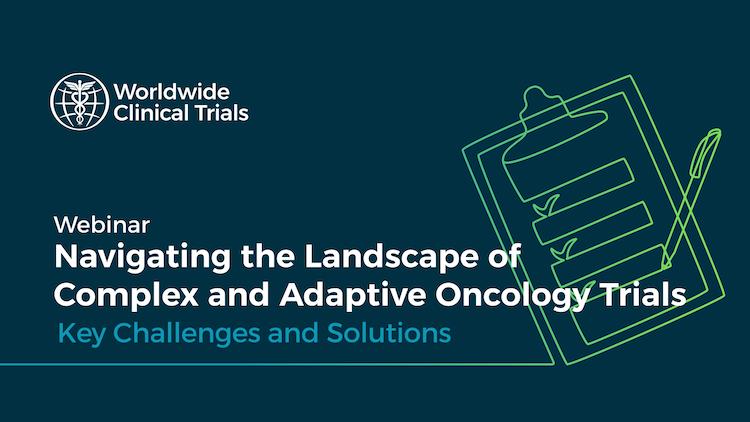
In the last few decades, oncology research has witnessed countless innovations and breakthroughs, significantly extending the lives of those affected by cancer and improving their quality of life. The FDA Oncology Center of Excellence (OCE) is committed to further enhancing oncology research and as a result, has recently implemented several projects aimed to revolutionize oncology clinical trials.
At Worldwide, Matt Cooper and Jim Eamma, our Executive Directors, Therapeutic Strategy Leads in Oncology, shed light on the intricacies of modern oncology trials in their recent webinar, “Navigating the Landscape of Complex & Adaptive Oncology Trials.” Their webinar highlighted key initiatives like Project Optimus, recent study design trends, and the benefit a Bayesian model can have on your drug development program. Find key highlights from the webinar below, and check out the webinar for a full overview!
FDA’s Project Optimus: Revolutionizing Dose Optimization
In their webinar, Matt and Jim highlight some of the early and late phase projects the OCE has implemented. Among the late phase ones include:
- Project Pragmatica: Brings real-world standard of care practices into the clinical research setting to help ease patient burden
- Project Orbis: Brings drugs and devices in clinical development that show significant efficacy to countries and patients in which the clinical trial is not running
- Project Equity: Focuses on diversity in clinical research, requiring not only a diversity action plan but a diversity implementation plan as well
A major project of focus from the OCE is Project Optimus, a forward-thinking initiative aimed to reform the dose optimization and selection process in oncology drug development. “The aim is to try and look at, going forward, a dose-finding optimization model that is going to be really good at emphasizing the selection of the dose and maximizing the efficacy of the drug as well its safety and tolerability profiles,” says Matt.
Traditionally, dose-finding has focused on determining the maximum tolerated dose (MTD), often leaving optimization for later stages. However, Project Optimus emphasizes the importance of dose-finding studies in early clinical development. By comparing the minimum biologically active dose with the highest tolerable dose, researchers can maximize the efficacy of the drug while minimizing its toxicity.
How Does Project Optimus Impact Your Study’s Operations?
The changes associated with Project Optimus have various operational impacts. A few ways to amplify patient enrollment rates and mitigate market delays include:
- Cultivate Site Relationships: Foster strong relationships with sites to foster early engagement, which will gain momentum for your study before it begins.
- Utilize Satellite Sites: Leverage satellite sites to increase patient enrollment and accelerate timelines.
- Leverage Real-Time Data: Medidata Global allows Worldwide the use of real-time data to see the most successful countries for specific patient populations and how many sites have enrolled patients for indications, enabling faster recruitment strategies.
Oncology Study Design Trends
In our webinar, Matt and Jim additionally spoke about emerging study design trends, showcasing the diversity of approaches in modern oncology trials. A few common study designs include:
- 3+3
- Accelerated Titration
- MTPI
- Randomization
- Endpoints
- Master Protocols
- Single Arm
- BOP2
Bayesian Study Designs
Among the study designs, two prominent Bayesian models stand out: Bayesian Logistic Regression Model (BLRM) and Bayesian Optimal Interval (BOIN). BLRM is renowned for its robust statistical framework, offering comprehensive safety rule profile and recommendations for dose escalation. Its reliance on statistical elements ensures a rigorous approach to dose optimization, providing researchers with valuable insights into safety and efficacy trends. However, BLRM tends to be more conservative compared to other Bayesian designs, prioritizing patient safety above all else.
BOIN presents a simpler alternative, particularly advantageous for researchers using a Bayesian methodology for the first time. This model utilized predetermined tables and a user-friendly computer program, eliminating the need for extensive statistical expertise. Its simplicity and ease of implementation make it an appealing option for streamlining trial processes and facilitating efficient decision-making.
There are several strategies to maximize the success of BOIN, one of which is to identify dose-limiting toxicities (DLTs) early. “At Worldwide, we put a ton of emphasis, especially in your dose escalation and expansion studies, in teaching our CRAs to identify the DLTs, as there are some studies and some protocols that have very unique or very idiosyncratic DLT criteria… Whether they’re at the site and doing on-site monitoring or if they’re looking at the EMR and doing remote monitoring, we focus on being able to identify the DLTs and catch anything because we don’t want any setbacks or delays,” says Jim.
Other strategies we employ include:
- Proactively screening patients prior to the next cohort dosing
- Meeting intra-subject escalation criteria
- Biweekly PI calls to discuss patient safety and cohort dosing plans
To determine the most appropriate BOIN for your oncology drug development program, check out our infographic.
Leverage Worldwide’s Oncology Capabilities
With our extensive experience in implementing OCE’s projects and utilizing diverse study designs, Worldwide is poised to drive forward the next generation of oncology research. If you’re interested in learning more about current study design trends and the intricacies of Project Optimus, make sure to watch the full Xtalks webinar with Matt Cooper and Jim Eamma today!
Dive deeper into OCE’s inclusivity and accessibility projects and the projects that will most impact drug development.
- SEO Powered Content & PR Distribution. Get Amplified Today.
- PlatoData.Network Vertical Generative Ai. Empower Yourself. Access Here.
- PlatoAiStream. Web3 Intelligence. Knowledge Amplified. Access Here.
- PlatoESG. Carbon, CleanTech, Energy, Environment, Solar, Waste Management. Access Here.
- PlatoHealth. Biotech and Clinical Trials Intelligence. Access Here.
- Source: https://www.worldwide.com/blog/2024/06/project-optimus-and-study-design-trends/
